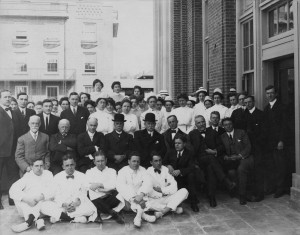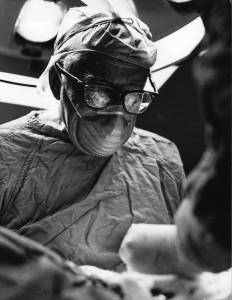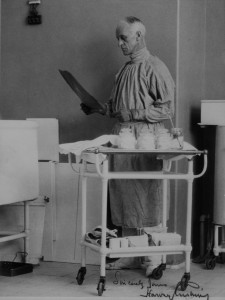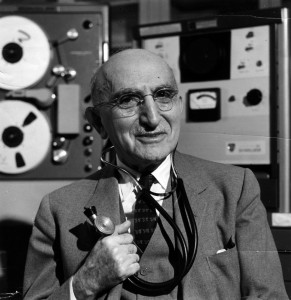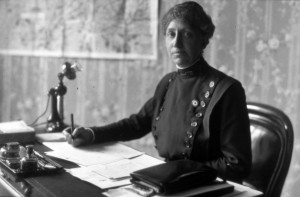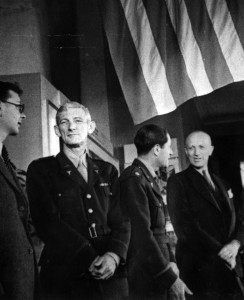Brigham and Women’s Hospital Archives Collections—Spotlight
Remembering Brigham’s women volunteers of World War I via a storied artifact![Brigham and Women's Hospital Archives, BWH c3, Peter Bent Brigham Hospital Records. Volunteer workers in the Home Work Department of the New England Surgical Dressings Committee workrooms at 238 Beacon St. (Residence of Mrs. L. Carteret Fenno). Left to right: Miss Elizabeth Train, Mrs. Hatherly Foster, Jr., Mrs. Charles Rowley. [Photo is stamped with date "MAR 17 1918". Photo purchased for BWH archives from Historic Images, Memphis Tennessee, via eBay.]](https://cms.www.countway.harvard.edu/wp/wp-content/uploads/2016/05/PBBH_NESurgDressings_1918_001a.jpg)
“An organization called the Surgical Dressings Committee has started work in the Zander Ward of the Peter Bent Brigham Hospital. The office, workroom, storage and packing rooms are all in the ward. Here fifty different surgical dressings are prepared for the small French hospitals. There are over 300 volunteers from Greater Boston who work in groups for several hours each day under the supervision of trained nurses, the work being inspected by the hospital surgeons. After sterilization, the dressings are packed for transportation in hermetically sealed tins. These are placed in wooden boxes, of a size and shape to be easily handled.”
This American Journal of Nursing article published in December of 1915 announced the start of an organization whose work became so important to saving the lives of wounded soldiers that Dr. Harvey Cushing, 1st Surgeon-in-Chief of the Peter Bent Brigham Hospital and leader of Base Hospital #5, the Harvard military hospital unit serving in France during WWI, 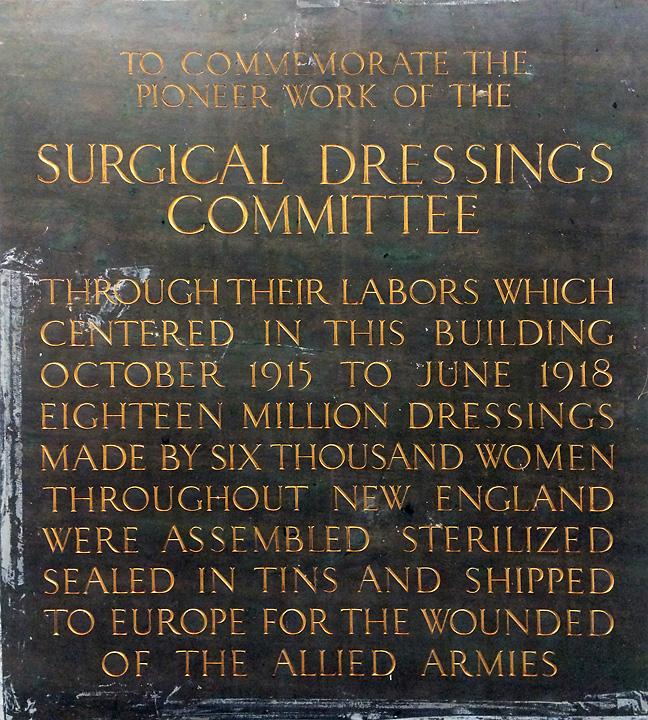 was moved to create a memorial tablet for it with the intention of permanently embedding it in the walls of his hospital. The 3 foot tall plaque—gold engraved letters in bronze mounted on stone—was installed just outside the Zander Ward and dedicated in a formal ceremony on May 25th 1923. It was removed and placed in storage at an unknown point years later, probably during one of the hospital’s many remodeling projects. Currently the plaque is cared for at the Center for the History of Medicine in the Countway Library as one of the treasures of the Brigham and Women’s Hospital Archives Collections. The engraved text reads:
was moved to create a memorial tablet for it with the intention of permanently embedding it in the walls of his hospital. The 3 foot tall plaque—gold engraved letters in bronze mounted on stone—was installed just outside the Zander Ward and dedicated in a formal ceremony on May 25th 1923. It was removed and placed in storage at an unknown point years later, probably during one of the hospital’s many remodeling projects. Currently the plaque is cared for at the Center for the History of Medicine in the Countway Library as one of the treasures of the Brigham and Women’s Hospital Archives Collections. The engraved text reads:
“To commemorate the pioneer work of the Surgical Dressings Committee. Through their labors, which centered in this building October 1915 to June 1918, eighteen million dressings made by six thousand women throughout New England were assembled, sterilized, sealed in tins, and shipped to Europe for the wounded of the allied armies.”
The Boston Medical and Surgical Journal in July of 1923 reprinted “The Boston Tins,” Cushing’s address at the unveiling of the plaque. In it he described the two approaches necessary for one to convalesce from the devastation of war: forgetfulness—and remembrance.
“…to dwell upon such bright episodes as glow from the background of our otherwise somber recollections—the times and occasions when people did sane, wholehearted and unselfish things in behalf of a stricken world. Many of these things were done by women.”
We know much about the things done by the women of the Surgical Dressings Committee and of Cushing’s efforts to memorialize them, 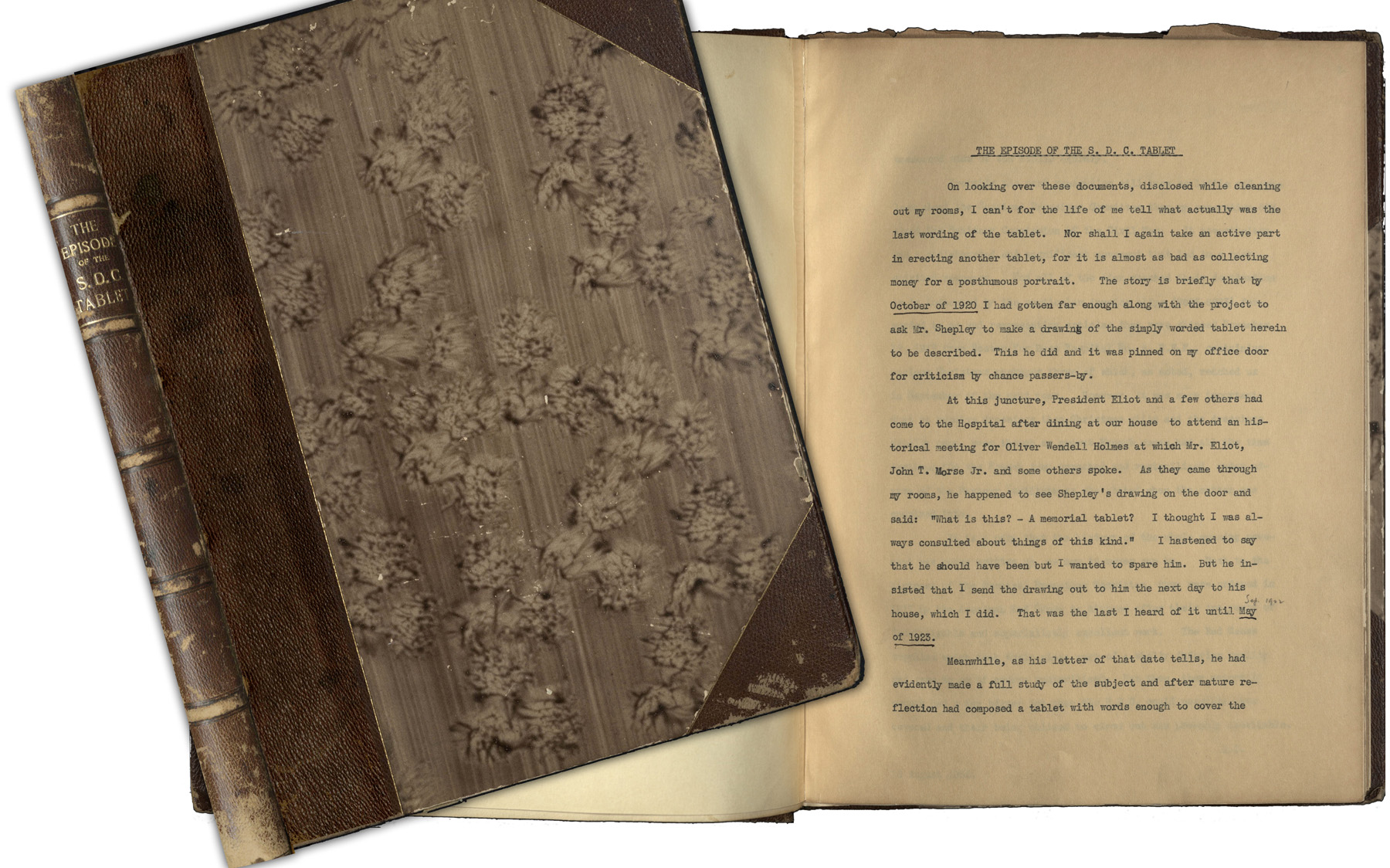 from the letters, receipts, and recollections assembled and bound in a scrapbook by Dr. Cushing himself. In 1972, someone doing a closet cleaning in a hospital conference room found and discarded the dusty volume. Luckily, an observant surgical resident, recognizing its historic value, rescued it from the trash. He recently donated the scrapbook back to the Brigham and Women’s Hospital for the Archives.
from the letters, receipts, and recollections assembled and bound in a scrapbook by Dr. Cushing himself. In 1972, someone doing a closet cleaning in a hospital conference room found and discarded the dusty volume. Luckily, an observant surgical resident, recognizing its historic value, rescued it from the trash. He recently donated the scrapbook back to the Brigham and Women’s Hospital for the Archives.
The 100th anniversary of the “Great War” seems an opportune time to be reminded, thanks to the plaque and the scrapbook, that the name, Brigham and Women’s Hospital, reflects a legacy, not only of caring for women patients, but also for the historic service of its women staff and volunteers.
